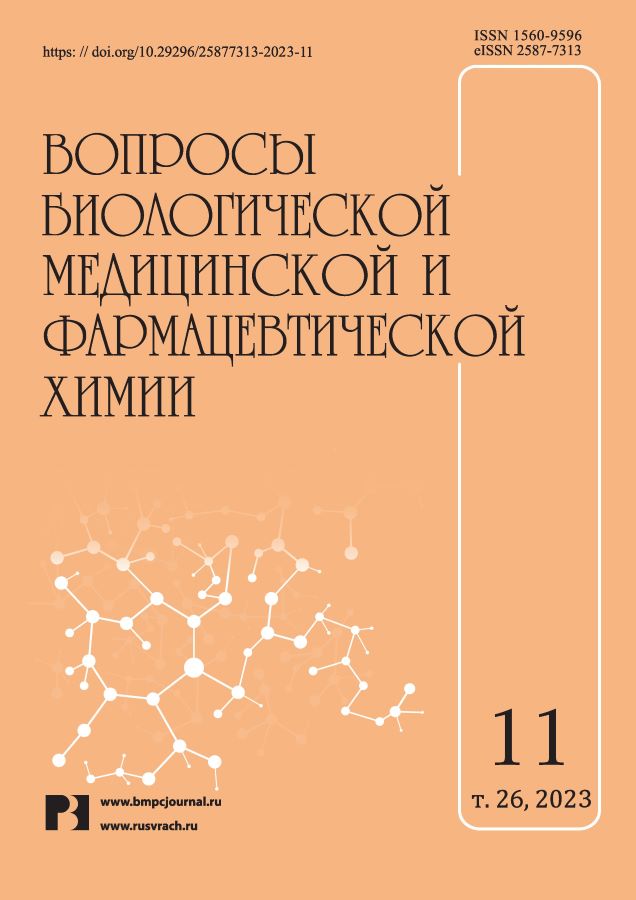Фитохимическое обоснование комплексной переработки околоплодника Juglans nigra L.
- Авторы: Бутенко Л.И.1, Степанова Н.Н.1, Грицаенко К.А.1, Дайронас Ж.В.1
-
Учреждения:
- Пятигорский медико-фармацевтический институт – филиал ФГБОУ ВО ВолгГМУ МЗ РФ
- Выпуск: Том 26, № 11 (2023)
- Страницы: 3-8
- Раздел: Фармацевтическая химия
- URL: https://journals.eco-vector.com/1560-9596/article/view/623555
- DOI: https://doi.org/10.29296/25877313-2023-11-01
- ID: 623555
Цитировать
Полный текст
Аннотация
Актуальность. Целевыми продуктами при комплексной переработке лекарственного растительного сырья могут быть как высокоактивные фармацевтические субстанции, так и вспомогательные вещества. Например, нафтохиноны используются как противомикробные, противогрибковые средства, а полисахариды – как наполнители, загустители, сорбенты. Сырьевыми источниками последних служат плоды, корнеплоды, отходы деревообрабатывающей промышленности. Разработка малоотходных технологий переработки лекарственного растительного сырья является актуальным направлением исследований.
Цель работы – на основании фитохимического исследования околоплодника ореха чёрного обосновать возможность его комплексной переработки с получением биологически активных и вспомогательных субстанций по малоотходной технологии.
Материал и методы. Объект исследования – околоплодники ореха чёрного (Juglans nigra L.) сем. ореховые (Juglandaceae), собранные в октябре 2021 года в г. Пятигорске на территории парка, высушенные и измельченные в порошок. Нафтохиноны обнаруживали методом тонкослойной хроматографии. Содержание суммы нафтохинонов в пересчёте на юглон определяли методом спектрофотометрии, суммы экстрактивных веществ, выделяемых хлороформом, полисахаридов – гравиметрии, средней молярной массы водорастворимых полисахаридов – вискозиметрии, поверхностную активность водорастворимых полисахаридов – сталагмометрически, коэффициент распределения полисахаридов в системе диэтиловый эфир – вода – кондуктометрии.
Результаты. Фитохимически обоснована возможность получения в одном технологическом процессе двух продуктов: 1) активной фармацевтической субстанции (выход 1,5%) для получения наружных форм (мазей, кремов), обладающих противогрибковой, противовирусной активностью, содержащей нафтохиноны (сумма юглона и его производных 12,41±0,3%); 2) вспомогательных веществ – полисахаридов (выход 8,8%), молекулы которых имеют нитевидную структуру, что объясняет их хорошую растворимость в воде, поверхностную активностью и свойства полиэлектролита.
Выводы. В результате фитохимического изучения околоплодника ореха чёрного (Juglans nigra L.) установлено, что в процессе комплексной переработки можно получить как субстанцию, содержащую полифенольные соединения, так и полисахариды, пригодные в качестве вспомогательных веществ.
Ключевые слова
Полный текст
Об авторах
Л. И. Бутенко
Пятигорский медико-фармацевтический институт – филиал ФГБОУ ВО ВолгГМУ МЗ РФ
Автор, ответственный за переписку.
Email: polechka2802@yandex.ru
к.х.н., доцент кафедры органической химии
Россия, г. ПятигорскН. Н. Степанова
Пятигорский медико-фармацевтический институт – филиал ФГБОУ ВО ВолгГМУ МЗ РФ
Email: l.i.sherbakova@pmedpharm.ru
к.фарм.н., доцент кафедры неорганической, физической и коллоидной химии
Россия, г. ПятигорскК. А. Грицаенко
Пятигорский медико-фармацевтический институт – филиал ФГБОУ ВО ВолгГМУ МЗ РФ
Email: gritsaencko.ksenia2017@yandex.ru
студентка
Россия, г. ПятигорскЖ. В. Дайронас
Пятигорский медико-фармацевтический институт – филиал ФГБОУ ВО ВолгГМУ МЗ РФ
Email: daironas@mail.ru
д.фарм.н., профессор кафедры фармакогнозии, ботаники и технологии фитопрепаратов
Россия, г. ПятигорскСписок литературы
- Щербакова Е.В., Ольховатов Е.А., Дробицкая З.И. Способ получения пектина из плодовых оболочек ореха черного. Патент РФ 2414145. Патентообладатель ФГОУ ВПО «Кубанский государственный аграрный университет». 2011.
- Дайронас Ж.В., Зилфикаров И.Н., Корочинский А.В. Инновационные технологии в производстве фитопрепаратов ореха черного. Разработка и регистрация лекарственных средств. 2014; 3 (8): 62–66.
- Kashyap R., Sharma R., Uniyal S.K. Bioindicator responses and performance of plant species along a vehicular pollution gradient in western Himalaya. Environ Monit Assess. 2018; 190(5): 302. doi: 10.1007/s10661-018-6682-7.
- Mohammadi A., Mokhtari M., Arani A.M. et al. Biomonitoring levels of airborne metals around Urmia Lake using deciduous trees and evaluation of their tolerance for greenbelt development. Environ Sci Pollut Res Int. 2018; 25(21): 21138–21148. doi: 10.1007/s11356-018-1899-0.
- Blood B.L., Klingeman W.E., Paschen M.A., et al. Behavioral Responses of Pityophthorus juglandis (Coleoptera: Curculio-nidae: Scolytinae) to Volatiles of Black Walnut and Geosmithia morbida (Ascomycota: Hypocreales: Bionectriaceae), the Cau-sal Agent of Thousand Cankers Disease. Environ Entomol. 2018; 47(2): 412–421. doi: 10.1093/ee/nvx194.
- Paudel P., Satyal P., Dosoky N., et al. Juglans regia and J. nigra, two trees important in traditional medicine: A comparison of leaf essential oil compositions and biological activities. Natural Product Communications. 2013; 8(10): 1481–1486.
- Ho K.V., Roy A., Foote S., et al. Profiling Anticancer and An-tioxidant Activities of Phenolic Compounds Present in Black Walnuts (Juglans nigra) Using a High-Throughput Screening Approach. Molecules. 2020; 25(19): 4516. doi: 10.3390/molecules25194516.
- Дайронас Ж.В., Зилфикаров И.Н., Корочинский А.В., Корочинская В.В. Определение нафтохинонов в сырье и фитопрепарате ореха черного – Juglans nigra L. Фармация. 2013; 4: 12–14.
- Государственная фармакопея Российской Федерации: в 4 т. XIV изд. М. 2018. [Электронный ресурс]. Режим доступа: http://www.femb.ru.
- Жилина О.М., Мыкоц Л.П., Степанова Н.Н. Изучение пектинсодержащих веществ, выделенных из травы вики обрубленной (Vicia truncatula). Разработка, исследование и маркетинг новой фармацевтической продукции: сборник научных трудов. Ижевск: ООО «Принт», 2017; 72: 270–274.
Дополнительные файлы






